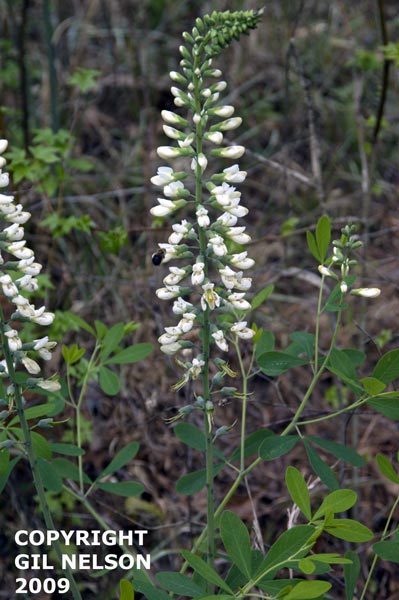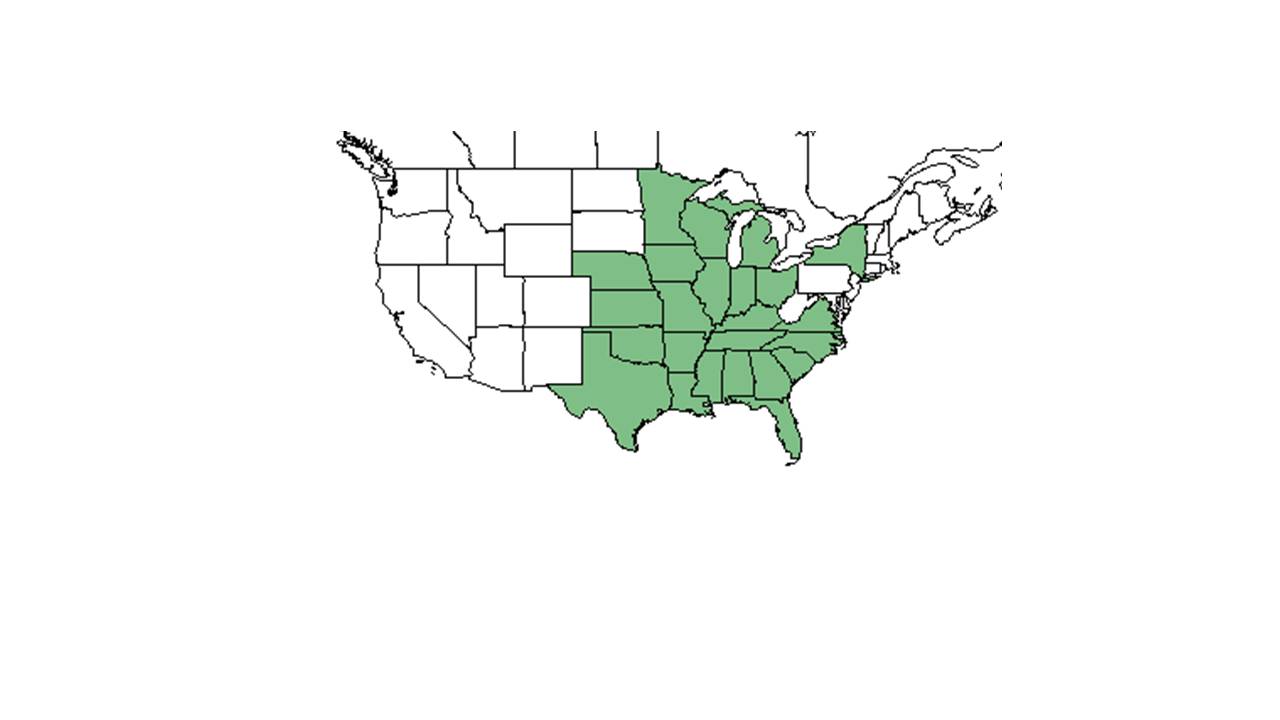Difference between revisions of "Baptisia alba"
KatieMccoy (talk | contribs) (→Description) |
|||
| Line 22: | Line 22: | ||
==Description== | ==Description== | ||
<!-- Basic life history facts such as annual/perrenial, monoecious/dioecious, root morphology, seed type, etc. --> | <!-- Basic life history facts such as annual/perrenial, monoecious/dioecious, root morphology, seed type, etc. --> | ||
| − | For the ''Baptisia'' genus, the group are rhizomatous perennial herbs which blackening when dried. The leaves are 3-foliolate or rarely simple. The flowers are papilionaceous, either solitary or in axillary or in terminal racemes. The calyx is persistent, is 4-5 toothed (or lobed), is campanulate, the upper lip is entire, the is notched or 2-lobed. The petals can be white, cream, yellow or blue in color. The petals are orbicular to reniform and usually reflexed and are shorter than the wing and keel petals. There are 10 stamens, the filaments are distinct, ovary stipitate in shape. The legume has a papery to almost woody feel in texture, is inflated, stalked, globose to cylindric in shape, and contains many small seeds | + | For the ''Baptisia'' genus, the group are rhizomatous perennial herbs which blackening when dried. The leaves are 3-foliolate or rarely simple. The flowers are papilionaceous, either solitary or in axillary or in terminal racemes. The calyx is persistent, is 4-5 toothed (or lobed), is campanulate, the upper lip is entire, the is notched or 2-lobed. The petals can be white, cream, yellow or blue in color. The petals are orbicular to reniform and usually reflexed and are shorter than the wing and keel petals. There are 10 stamens, the filaments are distinct, ovary stipitate in shape. The legume has a papery to almost woody feel in texture, is inflated, stalked, globose to cylindric in shape, and contains many small seeds<ref name="radford".Radford, Albert E., Harry E. Ahles, and C. Ritchie Bell. Manual of the Vascular Flora of the Carolinas. 1964, 1968. The University of North Carolina Press. 580-2. Print.</ref>. |
| − | Specifically, for ''Baptisia alba'', the plants are glaucous, glabrous or close to it. The plants grow up to 0.5-1.2 m tall. The leaves contains the 3-foliolate, the leaflets are elliptic, oblanceolate to obovate in shape, and growing up to 2-4 (6) cm long, and 0.8- 1.5 cm wide. The stipules become deciduous, deltoid to lanceolate, and grow up to 5 mm long. The racemes are long, slender, and terminal, and growing up to 1.5-5 dm long. The (2) pedicels grow up to 4-12 mm long subtended by caducous bracts that grow up to 5-7 mm long. The calyx is glabrous except for the short-ciliate margin. When dried, changes to a greenish yellow to straw color. Of the calyx, the upper lip is entire or slightly emarginated, the corolla is white in color, and the keel and wing petals grow up to 1.2-1.8 cm long. The legume is usually erect, is light brown in color, is cylindric in shape, and grows up to 2-3.5 cm long and up to 5-10 mm in diameter | + | Specifically, for ''Baptisia alba'', the plants are glaucous, glabrous or close to it. The plants grow up to 0.5-1.2 m tall. The leaves contains the 3-foliolate, the leaflets are elliptic, oblanceolate to obovate in shape, and growing up to 2-4 (6) cm long, and 0.8- 1.5 cm wide. The stipules become deciduous, deltoid to lanceolate, and grow up to 5 mm long. The racemes are long, slender, and terminal, and growing up to 1.5-5 dm long. The (2) pedicels grow up to 4-12 mm long subtended by caducous bracts that grow up to 5-7 mm long. The calyx is glabrous except for the short-ciliate margin. When dried, changes to a greenish yellow to straw color. Of the calyx, the upper lip is entire or slightly emarginated, the corolla is white in color, and the keel and wing petals grow up to 1.2-1.8 cm long. The legume is usually erect, is light brown in color, is cylindric in shape, and grows up to 2-3.5 cm long and up to 5-10 mm in diameter<ref name="radford"/>. |
==Distribution== | ==Distribution== | ||
Revision as of 19:30, 1 April 2016
| Baptisia alba | |
|---|---|

| |
| photo by Gil Nelson | |
| Scientific classification | |
| Kingdom: | Plantae |
| Division: | Magnoliophyta - Flowering plants |
| Class: | Magnoliopsida - Dicotyledons |
| Order: | Fabales |
| Family: | Fabaceae ⁄ Leguminosae |
| Genus: | Baptisia |
| Species: | B. alba |
| Binomial name | |
| Baptisia alba (L.) Farw. | |

| |
| Natural range of Baptisia alba from USDA NRCS Plants Database. | |
Common Name: white wild indigo
Taxonomic notes
Synonyms: Baptisia alba var. alba; B. lactea (Rafinesque) Thieret var. obovata (Larisey) Isely; B. lactea var. pendula (Larisey) B.L. Turner; B. pendula Larisey; B. pendula var. pendula; B. pendula var. obovata Larisey
Description
For the Baptisia genus, the group are rhizomatous perennial herbs which blackening when dried. The leaves are 3-foliolate or rarely simple. The flowers are papilionaceous, either solitary or in axillary or in terminal racemes. The calyx is persistent, is 4-5 toothed (or lobed), is campanulate, the upper lip is entire, the is notched or 2-lobed. The petals can be white, cream, yellow or blue in color. The petals are orbicular to reniform and usually reflexed and are shorter than the wing and keel petals. There are 10 stamens, the filaments are distinct, ovary stipitate in shape. The legume has a papery to almost woody feel in texture, is inflated, stalked, globose to cylindric in shape, and contains many small seedsCite error: Closing </ref> missing for <ref> tag
</gallery>
References and notes
Florida State University Robert K. Godfrey Herbarium database. URL: http://herbarium.bio.fsu.edu. Last accessed: June 2014. Collectors: H. E. Ahles, L. C. Anderson, R. Athey, K. E. Blum, M. B. Brooks, J. R. Burkhalter, A. F. Clewell, D.S. Correll, R. F. Doren, W. H. Duncan, L. R. Fox, J. P. Gillespie, R. K. Godfrey, N. C. Henderson, R. H. Houk, G. R. Knight, R. Komarek, R. Kral, R. L. Lazor, R.S. Leisner, K. MacClendon, A. W. Macias, S. McDaniel, R. Mitchell, G. W. Ramsey, J. D. Ray Jr., L. M. Umbach, and R. L. Wilbur. States and Counties: Florida: Calhoun, Dixie, Escambia, Gadsden, Jackson, Jefferson, Lafayette, Leon, Madison, Suwannee, Taylor, Wakulla, and Washington. Georgia: Grady, Fannin, Lowndes, Taliaferro, Thomas, and White. Kansas: Franklin. Mississippi: Hancock and Panola. Missouri: Vernon. North Carolina: Stanly. South Carolina: Lancaster, Richland, and Sumter. Texas: Red River.
Radford, Albert E., Harry E. Ahles, and C. Ritchie Bell. Manual of the Vascular Flora of the Carolinas. 1964, 1968. The University of North Carolina Press. 580-2. Print.